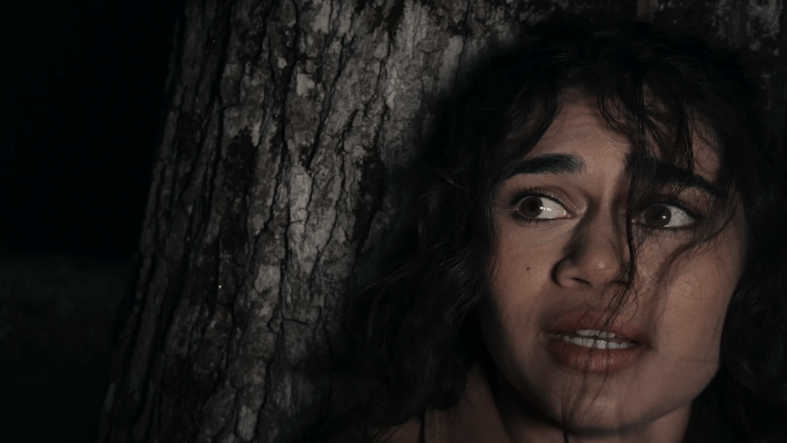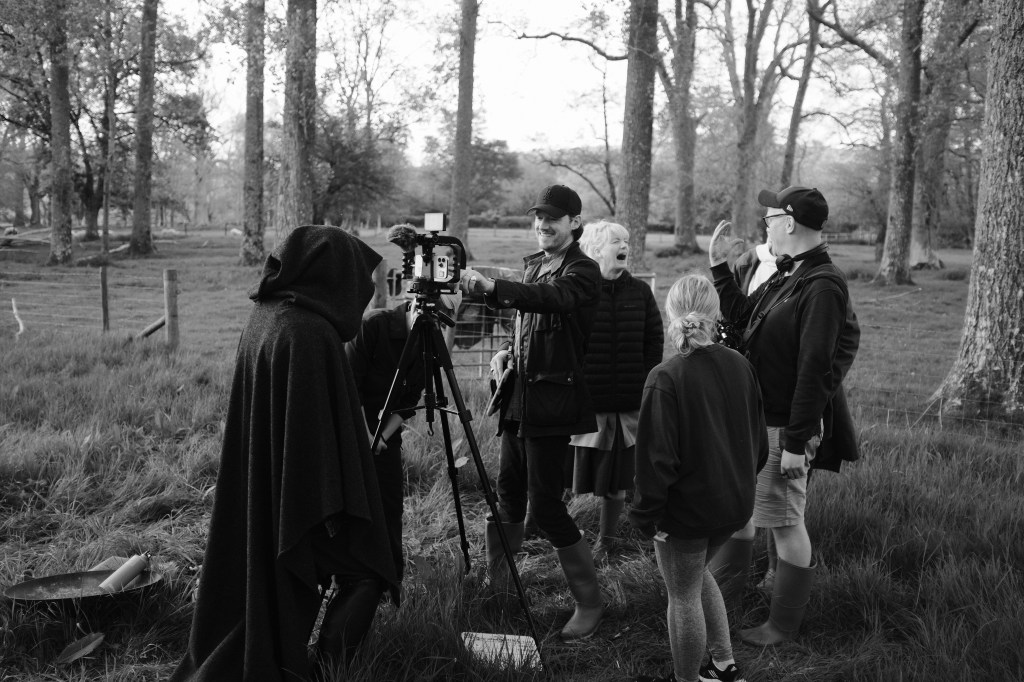“Why are they still holding a camera?”: ‘Dagr Director and Writer Break Down Their UK Found-Footage Folk Horror

Halloween Night 1992. 12-year-old Matthew and his brother Graham had their eyes glued to the TV screen, witnessing a fact-based paranormal investigation in real-time (or so they thought). What’s on air? Ghostwatch, the BBC TV special that shocked the British populace with a live investigation of a haunted Greater London house.
With actual BBC presenters-cum-household names playing themselves, the state broadcasting network of the nation pulled off such a convincing Halloween prank that the BBC switchboard was flooded with over a million panic-struck phone calls.
Ghostwatch was never broadcast in the UK again but went on to mark a watershed chapter in found-footage horror, preceding the likes of The Blair Witch Project and Paranormal Activity across the Atlantic.
“It kind of broke Britain for a few days. I still remember sitting there on the sofa when I was twelve,” Matthew Butler-Hart recalls now, ahead of a screening of his fifth directorial feature Dagr. “Maybe, it [Ghostwatch] wasn’t an influence on the story per se, but you know, there’s that certain…feeling that it gave me.” He continues when asked about Dagr’s influences.
Also Read: Mike Flanagan Loves This Found Footage Chiller: “…lingers with you after the credits have rolled”
While the Somerset-based director-writer-producer has flirted with horror before (The Isle), Dagr is his first foray into the found-footage genre. Listed among its executive producers are British acting royalty Sir Ian McKellen and Conleth Hill aka Game of Thrones’ Lord Varys. Both have starred in Butler-Hart’s previous films (with him even assisting McKellen on 2006’s The Da Vinci Code).
But at its core, Dagr is a low-budget indie and a family affair with the cast including brother Graham and wife Tori Butler-Hart. The latter also serves as co-writer and co-producer under the couple’s Fizz and Ginger Productions banner.
While Dagr has obvious nods to found-footage trendsetters like Blair Witch, the folk horror/dark comedy also draws inspiration from Druid sorcery and Welsh folklore. The film’s very title is Welsh for “dagger”, a totemic motif that appears along with a chilling feather mask and a multitude of cameras.
Welsh speakers and Celtic history aficionados should be pleased. Interestingly, the latter half’s music incorporates a “Blood Cult Chorus”, a Welsh throat chant of a song that builds up the atmospheric dread.
Instead of just walking down a familiar “lost footage” route, Dagr toys around with a video-within-a-video narrative. The story kicks off with two Gen-Z influencers cheekily christened Thelma and Louise (Riz Moritz and Ellie Duckles), social media stars who style themselves as modern-day Robinhoods as they stage elaborate pranks to hoodwink the rich and distribute their spoils among the needy. The intentions might be good but attention-seeking egotism is also on their mind.
Also Read: ‘Lola’ Director Andrew Legge On Crafting Time Machines And Found Footage
When Thelma and Louise drive down to a scantily-populated countryside manor posing as caterers in a fancy ad shoot, they encounter an iPad that records the whereabouts of the film crew. This crew, in turn, had discovered pre-existing archival footage of an occultist’s findings about the Druids. Slow-burning tension, ominous chanting, and nocturnal forest scares follow.
As is common knowledge, the Druids were high-ranking priests among the Celtic cultures of ancient Europe. But with stale fantasy and horror genre outings, Druids have succumbed to stereotypical depictions as bearded sorcerers of the dark arts.
“I read that there was a guy in the 18th century who basically discovered these ancient Druidic texts and people listened to him, thinking that this is amazing. And it turns out he made them up.” Butler-Hart attempts to debunk some myths.

“It was all fake stuff but you know the Druidry in the old days, thousands of years ago, was all very equal and it wasn’t patriarchal or anything like that. 18th century onwards, men mostly got fixated with Druidry and turned it into something very, very different.”
Perhaps what made the Druids a subject of much mystery was the fact that Druidic doctrines prevented them from recording their knowledge in the written form. While historians scratch their heads, Druidism endures as a fresh field for many an occult expert (like the one in Dagr).
Also Read: ‘Lola’ Director Andrew Legge On Crafting Time Machines And Found Footage
Chancing upon Druid knowledge feels like you’re meddling with something forbidden. But there is no one Book of the Dead to stumble upon. The multi-timeline concept is how Dagr injects freshness into the otherwise oversaturated found-footage genre. Of course, there are occasional genre exceptions within the UK itself, like Rob Savage’s pandemic-era debut Host which innovatively played out as one haunted Zoom call.
Dagr is similar in terms of its gritty, raw video footage, a creative choice that partly stemmed from budgetary constraints. Filmed entirely on an iPhone over the course of nine days, even the central location was booked on Airbnb when the script was still incomplete.
Producer-writer Tori Butler-Hart (who also plays the ad shoot’s director) found the Welsh countryside manor on Airbnb. The property owner was fine with filming a Druid-inspired horror in the premises but he was the one who set the production deadline.
“He said that we could have it for two weeks as that was between his birthday weekend and the King’s Coronation and they wanted to have parties on both weekends!” Matthew Butler-Hart says. “I think it actually helped us to get the film made, because if we’d agonized over a script like we normally do, we’d still be writing it and the film may never have happened to be honest.”
Also Read: ‘Frogman’ Is Cryptid Found Footage Done Right [Popcorn Frights 2023 Review]
Filming everything on an iPhone made for another time-saving approach. Tori Butler-Hart adds, “Because we shot everything on iPhone, we could do so much more. You didn’t have those really, really long set-up times where you’re setting up a rig or you’ve got to get a dolly in. We were using a camera that’s so tiny and maneuverable; it means that we could do things like just throwing the camera downstairs, just improvising however we can.”

Improvisation is also evident from the way the couple’s screenplay played out. With both husband and wife initially trained as actors, the Butler-Harts offered free rein to the cast to play around with the manuscript. This is the reason why the cast members are all provided with “additional material” writing credits.
Amidst all this writer-actor collaboration, there was also the ordeal of injecting an underlying rationality behind every camera movement. As Tori Butler-Hart puts it, “I think that’s the one thing that you think about when you watch found footage films, there is always that element of, ‘why are they still holding a camera?’.”
Thankfully for the writers, Dagr’s Thelma and Louise aren’t on-the-run fugitives but social media-addicted pranksters. Early on in the film, Tori Butler-Hart’s character (also named Tori) pokes her eye into a handheld 8mm camera while name-dropping Fellini. Meanwhile, Thelma and Louise merely rely on their iPhones to capture anything and everything, from ominous farm animals to their latest thrift store finds. The Gen-Z-ers might not be obsessed with Italian Neorealism like Tori but capturing “cinema verité” is their very bread and butter.
Also Read: The Best Found Footage Of 2023
Reminiscing on this “livestream-ification” of found-footage horrors, Tori Butler-Hart says, “There are so many young people out there who really want to make a name for themselves and will go to any extreme length to get famous. And so, what would have perhaps seemed like a completely bizarre and unreasonable time to pull out the camera a few years ago, it is now quite possible.”
More than three decades have passed since Ghostwatch made Matthew Butler-Hart shiver. When asked about what his found-footage debut taught him, he remains amused with how Dagr allowed him to not always stick to the storyboard but depend on actors’ instincts as well.
“Going forward, with conventional filmmaking at least, I’ll still have that eye on precise visuals, but also invite actors to play more, and make sure that I can give them space to do that.”
He quickly adds: “Budget and schedule allowing!”
Dagr had a limited cinema release in the UK from 7 February. The film will be available on digital in the US, Canada, Australia and New Zealand on 2 April, followed by the UK and Ireland on 8 April 2024.
Categorized:Interviews

